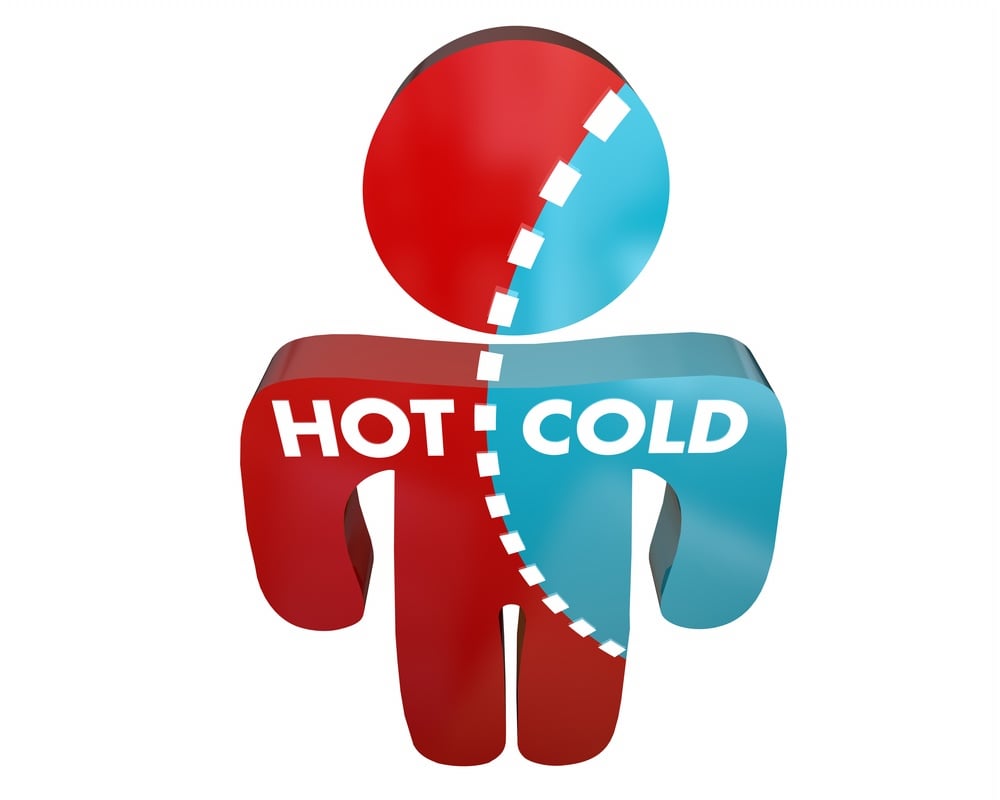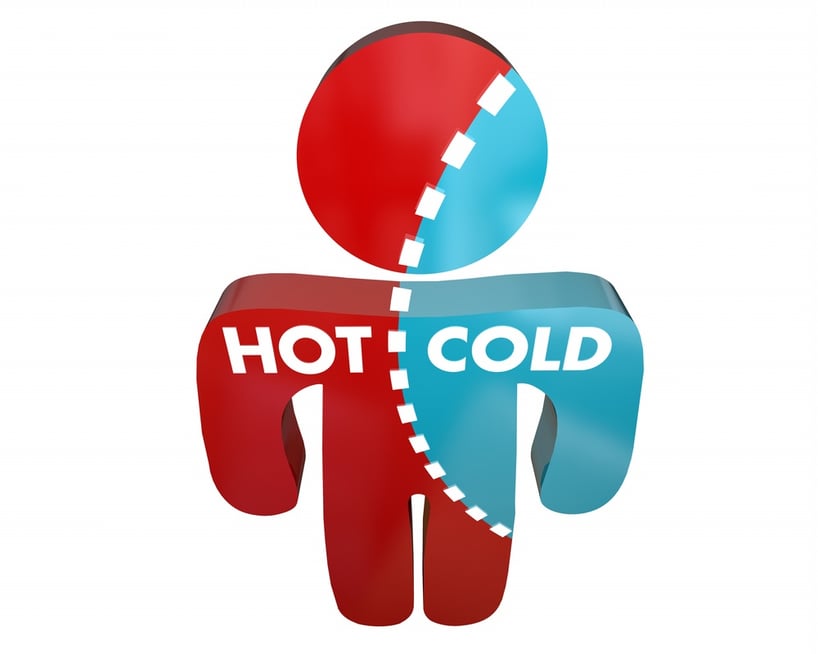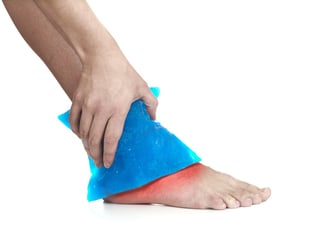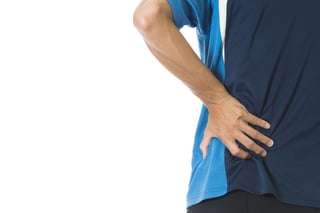5 Occasions to Use Heat Therapy
January 20th, 2017 | 4 min. read


Hot or cold? Is now the time for an ice pack or a hot compress?
A lot of confusion surrounds this issue. Advice from health care professionals may not always be consistent, and protocols for treating injuries sometimes do change when science finds better ways. The techniques you learned for handling an injury twenty years ago may no longer apply today.
It’s no surprise that many people are sometimes confused about what to do to speed healing and treat pain. If you have soreness or swelling in your joints or muscles, you may wonder, “When do I use cold therapy? When is the right time to use heat therapy?”
Heat therapy vs. Cold therapy: When to Use Each
Instinctively, most of us want to apply warmth to sore body parts. There’s something comforting about the feel of a hot compress, a heating pad, or a hot bath. But heat, which stimulates blood flow to an injured body part, isn’t always the best move.
Likewise, you may feel pain and think to use ice as a numbing agent. But cold therapy is a short-term solution and can actually damage tissue if you use it for too long. Cold is also not the right choice for treating certain types of pain or injury.
So when should you use each? Generally, you can follow this rule of thumb:
 Apply Cold to new or immediate injuries (for example, swollen ankles or fingers, stubbed toes, pulled muscles, or torn tendons).
Apply Cold to new or immediate injuries (for example, swollen ankles or fingers, stubbed toes, pulled muscles, or torn tendons).
- Cold — applied on and off in intervals — constricts vessels and slows blood flow to the site of the injury. This keeps swelling under control.
- Cold therapy (also called cryotherapy) is a good front-line approach to numbing nerve endings and and reducing fluid build-up. Keeping swelling and pain controlled allows you to use the affected body part.
Apply Heat to treat achy muscles and chronic pain.
- Heat has the opposite function of cold therapy. Applying heat to a body part stimulates blood circulation to the injury site. This oxygen-rich blood brings nutrients to the affected area, promoting healing. Heat also helps to remove lactic acid buildup from overtaxed muscles, which allows them to “un-clench.”
- Heat therapy (also called thermotherapy) is helpful in managing pain and discomfort from stiff and sore muscles and joints.
- A good way to remember when to use heat is to think of the phrase, “Heat to treat.”
- Whereas cold is most often used as a first-aid intervention, heat can be used in an ongoing fashion to treat and manage chronic pain or older injuries (older than three days).
There are exceptions to every rule, of course, but generally you can follow these guidelines unless a doctor tells you otherwise.
5 Ways to Use Heat Therapy
- After a workout — to sooth sore muscles. After exercising or overtaxing your muscles, they may feel tight, tired, or sore from tiny tears and a buildup of lactic acid. You have two options for treating post-workout muscle soreness.
- You can use locally applied heat (like a heat patch or heated bean bag) if you’re sore in just one area.
- Systemic heat (for example, soaking in hot tub or using a sauna) is helpful for the all-over aches and pains you might feel after playing sports or being on your feet all day. Many people like to use hydrotherapy for sore muscles, especially sore feet.
- Both methods promote circulation and help to remove lactic acid from the muscles, helping them to relax. Remember to hydrate and not to overdo it — especially if you’re exposing your entire body to thermotherapy. Twenty minutes of treatment at a time should be sufficient.
- To treat muscle spasms. A spasm is a series of sudden, involuntary contractions of a muscle. Spasms are the body’s warning to stop stressing the body part in question right now, and they tend to happen when we overexert ourselves suddenly. The contractions are usually so debilitating and severe that we stop what we’re doing and immediately clutch the muscle in question. (Think lower back spasms or charley horse leg cramps in the calf.)
- If you’re having serious, ongoing spasms that last longer than a few minutes, apply ice 20 minutes at a time for the first 3 days. After that, use heat therapy to loosen up your tight muscles and promote healing. Moist heat is recommended to avoid dehydration (examples: a hot tub soak or applying a warm, wet cloth.)
- To ease lower back pain and stiffness. For people with chronic lower back pain and stiffness, heat therapy can be an
 affordable approach to managing symptoms and improving range of motion. Heat stimulates the body to deliver nutrient-rich blood to damaged tissue surrounding the spine; this, in turn, promotes faster healing of tiny muscle tears. Thermotherapy also warms the muscles and tendons in your lower back, making them easier to stretch safely. Warm muscles are more flexible muscles.
affordable approach to managing symptoms and improving range of motion. Heat stimulates the body to deliver nutrient-rich blood to damaged tissue surrounding the spine; this, in turn, promotes faster healing of tiny muscle tears. Thermotherapy also warms the muscles and tendons in your lower back, making them easier to stretch safely. Warm muscles are more flexible muscles.
- To ease lower back pain, try localized heat packs applied to your back. Hot tubs, soaks, or heated wraps may also be helpful.
- To reduce sciatica pain. Sciatica nerve pain can feel like an electric shock, pins and needles, or shooting pain in your buttocks or leg. Often the pain radiates down the outside of the hip, sometimes traveling as far as the calf.
- Treating sciatica can involve a combination of therapies, both nonsurgical and surgical. Most people prefer to start out with a noninvasive approach — physical therapy and the application of cold and heat.
- Start out with cold therapy for the first 3 to 5 days (using cold for 20 minutes of each hour, applied to the lower back). Cold helps to reduce the initial nerve inflammation that causes the pain. Later, heat packs can be applied to your lower back to help manage ongoing discomfort. Soaking in a hot tub may also help to ease symptoms.
- To manage chronic arthritis symptoms. Excessive swelling from arthritis flare-ups can respond well to brief applications of cold packs or ice. However, for managing the day-to-day pain and stiffness of OA, heat is a reliable and easy technique you can use yourself, at home or at work.
- Applying heat packs, warm paraffin wax treatments, heat therapy gloves, or hot compresses to sore joints can help relieve pain and stiffness.
- Warming topical creams can also be helpful — for example, creams and gels that include capsaicin (the natural heating component of chili peppers).
- It’s important to note that heat is not a cure or treatment for disease of arthritis, but it can make it easier for you to cope with the discomfort.
Remember: never apply very hot cloths or heating pads directly to your skin. Heat sources should be warm to very warm, but never so hot that they can scald or blister you.
Also, stay hydrated— especially if you’re soaking in a warm tub or using a sauna or steam room. As with ice therapy, it’s best to limit the application of heat to 20 minutes at a time avoid further damaging your tissue or overheating yourself to the point of dehydration.
The bottom line: many different thermotherapy modalities exist to help treat pain and stiffness. When in doubt, consult with your doctor or physical therapist about the best method to address your particular symptoms.
Contact Coastal Orthopedics in Corpus Christi, Texas at 361.994.1166 or just click the button below to request your appointment today!
Article written by: Rob Williams, MD
Dr. Williams has been practicing orthopedic surgery in Corpus Christi since 1998. After graduating from Texas Tech hereceived his medical degree from the University of Texas at San Antonio. At the prestigious Campbell Clinic located at the University of Tennessee, Dr. Williams completed not only an Orthopedic Surgery Residency, but an additional year of Fellowship Training in Spine Surgery. Dr. Williams is dedicated to creating an excellent patient experience in the office or in the surgery suite.
Topics:

